
Food Safety Express for Food Trade 2012 (1 st Issue)
Published by the Centre for Food Safety
Feature Articles
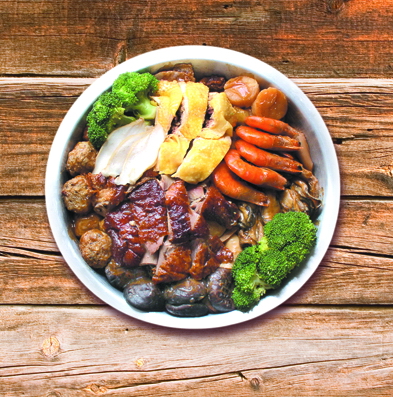
"Poon Choi"
"Poon Choi" is becoming more and more popular. The trade should pay attention to food safety when preparing the food.
"Poon Choi", a kind of traditional food among the indigenous residents of the walled villages in the New Territories, has a history of hundreds of years. Nowadays, "Poon Choi" feasts are still held in many walled villages on festive occasions. Many restaurants offer "Poon Choi" to entice customers, who can place an order and take the food home.
"Poon Choi" is a mixed dish with a lot of ingredients, and it involves a complicated preparation process. The cooked "Poon Choi" is usually kept for some time before served. Therefore, food handlers should take great care during the production and transportation of "Poon Choi" to prevent food contamination.
1. Careful Planning in Advance
- Ensure adequate manpower, space, utensils and ingredients, particularly stoves, refrigerators and heating equipment, etc, are available.
- Do not accept orders without due consideration of the handling capacity.
- Carefully plan the preparation schedule so that foods that are perishable or easily contaminated are not cooked too far in advance.
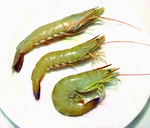
Ingredients should be purchased from reliable suppliers.
2. Purchasing and Receiving Ingredients
- Purchase ingredients from reliable suppliers.
- heck the food quality on receipt to ensure the foods are in good condition (in proper packaging, at an appropriate temperature, etc.)
3. Storage Facilities and Temperature Control
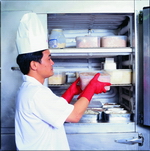
In the refrigerator, cooked foods should be put on upper shelves and raw foods on lower shelves.
- Stick to "first in, first out" principle for food retrieval.
- There should be enough space in refrigerators for storing raw and cooked foods separately. Cover raw and cooked foods properly and keep them on different shelves in the refrigerator. Cooked foods should be placed on upper shelves and raw ones on lower shelves to prevent cross-contamination.
- Keep chillers at 4℃ or below and freezers at -18℃ or below.
4. Food Preparation
- Clean and sanitise all utensils thoroughly.
- Defrost frozen foods either in chillers (4℃ or below) or under cool running water.
- Cook foods (especially high risk foods like seafood and poached chickens) thoroughly until their core temperature reaches 75℃ or above for at least 30 seconds.
- Keep cooked foods at above 60℃.
- Cover foods properly to prevent cross-contamination.
- Avoid preparing foods too far in advance.
Cooked "Poon Choi" should be put into serving containers as soon as possible to prevent food contamination.
5. Good Personal Hygiene Practices
- Staff should receive hygiene training regularly and follow good personal hygiene practices.
- Wash hands with liquid soap for at least 20 seconds before handling foods, after using toilets or touching unclean materials (e.g. after disposing of rubbish).
- Staff with contagious diseases like gastroenteritis or influenza should not handle foods.
"Poon Choi" must be kept at above 60℃ during delivery.
6. Delivery of "Poon Choi"

Vehicles used for food delivery must be kept clean.
- Keep hot "Poon Choi" at above 60℃ and chilled "Poon Choi" at 4℃ or below.
- Deliver "Poon Choi" to the destination as soon as possible and avoid keeping it at room temperature for a prolonged period.
- Transport "Poon Choi" in clean and covered thermally insulated containers.
- Keep the delivery vehicle clean.
- Upon delivery of "Poon Choi" to the destination, remind customers to reheat it thoroughly until its core temperature is above 75℃ before consumption and finish it in one go. Also, communal chopsticks and spoons should be used.
Readers' Corner
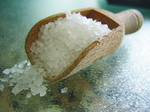
Stroke Prevention with a Low-sodium Diet
On the way to the supermarket, Dr Lau, Mrs Lau and their son Sam ran into Uncle Lee.
| Mrs Lau : |
Oh Dear, we haven't seen Uncle Lee only for some time, why has he changed so much? His speech becomes slurred, and he has to walk with a cane. |
| Dr Lau : | Yes, Uncle Lee was attacked by stoke recently. Fortunately, his family discovered he had a stroke and rushed him to the hospital without delay. He was then given timely diagnosis and proper treatment. But in the days ahead, he has to keep his illness under control, including changing his lifestyle, in order to reduce the risk of another stroke. |
| Mrs Lau : | Sam, do you know what stroke is? |
| Sam : | Sure, our biology teacher told us before. Before the stroke, Uncle Lee could move freely and speak clearly; now the stroke has affected some of his bodily functions. |
| Dr Lau : | Well, the medical term for stroke is cerebrovascular disease. To make it simple, it is caused by "blockage" or "rupture" of some blood vessels in the brain, leading to sudden obstruction of blood supply to it. The brain cells will die because of no supply of nutrients and oxygen, and the affected area of the brain will lose its ability to function. The resulting damage mainly depends on the location and extensiveness of the stroke. People suffered from a stroke may lose their mobility forever. For example, they may be paralysed, or even die in the attack. |
| Sam : | Dad, what is "blockage" or "rupture" of brain blood vessels? |
| Dr Lau : | "Blockage" of brain blood vessels means the blood vessels in the brain are obstructed, resulting in ischaemic stroke. "Rupture" of a brain artery means an artery in the brain bursts, resulting in haemorrhagic stroke. One of the most common causes of bleeding in the brain is high blood pressure, which can cause the small vessels to explode. |
| Sam : | Is high blood pressure the same as hypertension? Our teacher said that maintaining a balanced diet, regular exercise and an ideal body weight would reduce risk of developing eating-related diseases such as hypertension. Our teacher also said salt was placed at the "Eat the Least" level at the top of the Food Pyramid, and it should be taken in small amount. Dad, why do people have increased blood pressure as a result of eating too much salt? |
| Mrs Lau : | Common salt is mainly composed of sodium chloride, which exists as sodium ions and chloride ions in the human body. Sodium makes up 40% of common salt. In other words, there are 400 mg of sodium in each gram of salt. Sodium is a kind of mineral that helps to regulate water and pH balance in our body. Therefore, an adequate intake of common salt is vital for maintaining our life processes. Inadequate or a lack of sodium will lead to fatigue and weakness. |
| Dr Lau : | Under normal circumstances, the human body needs only 200 to 1 000 mg of sodium each day and any excess amount will be excreted in urine. Sodium is present in natural foods like milk, fish, meat, vegetables and fruits. As the level of sodium in these foods is enough to fulfill our daily sodium requirements, there is no need to obtain sodium from extra sources like salt or sodium-containing condiments. Prolonged excessive intake of sodium will upset the regulation of blood volume and impair the elasticity of blood vessels, thus elevating the blood pressure. |
| Sam : | Does it mean that we will not suffer from stroke if we do not take in salt at all? |
| Mrs Lau : | Common salt is not the only dietary source of sodium. Sodium is also found in natural foods, processed foods and condiments. Common Chinese-style condiments such as soy sauce, oyster sauce, chicken powder and fermented red bean curd, and assorted sauces and condiments used in western cuisine such as black pepper sauce, mustard and grated cheese are rich sources of sodium. Moreover, processed foods like ham, luncheon meat, bacon, sausages and Chinese sausages are also high in sodium. |
| Dr Lau : | As recommended by the World Health Organisation, a healthy adult should take in no more than 2 000 mg of sodium per day, which is equivalent to the amount present in a level teaspoon of common salt. The salt intake for children should be lower than that of adults. The younger one is, the less sodium one needs. |
| Mrs Lau : | So, who is more susceptible to hypertension and stroke? |
| Dr Lau : | There are many causes for hypertension and stroke. The risk of developing these two conditions increases with age. Those who are physically inactive, overweight or have an unhealthy diet are more prone to hypertension and stroke. |
| Mrs Lau : | Sam, I keep telling you not to have too many high sodium snacks, like sauce-mixing type instant noodles, potato chips, fish balls and siu mai. Do you know why? |
| Sam : | Yes. You mentioned that the dietary habit developed in childhood will often be carried on to adulthood. For instance, kids who are used to having heavily flavoured dishes will usually have a similar taste in food when they grow up. |
| Mrs Lau : | That's right. A high salt diet will lower the sensitivity to taste. As a result, one tends to go for more savoury and heavier tastes. On the contrary, if one keeps a low salt / sodium diet with light-flavoured foods, the risk of stroke in adulthood may be reduced. |
| Sam : | Dad, there is a Cantonese slang that goes "I've eaten more salt than you have of rice". Doesn't Grandma say so all the time? I bet her taste buds are really insensitive! |
| Dr Lau : | That's funny. Back then, we did not have a refrigerator. Shopping was not as easy and convenient as it is today, and that was why we would buy a large amount of food in each shopping trip. As unpreserved foods like fish and vegetables would go bad easily, Grandma tended to stock up on preserved products like salted fish, preserved mustard greens and canned food, which are all sodium-dense. That was how Grandma developed a taste for heavily flavoured food. Nowadays, however, food manufacturers have come up with various means of food preservation without using salt or sodium, like freezing and using legal and harmless substitutes of sodium. |
| Mrs Lau : | Our sense of taste is highly adaptable. Having switched to unsalted foods, our taste buds will get used to their natural tastes after a while. Under our influence, Grandma now prefers only fresh and light-flavoured foods. She does eat preserved foods once in a while, but only in small amounts. |
| Sam : | What kinds of snack are high in sodium and what kinds are low in sodium? |
| Mrs Lau : | Snacks high in sodium include biscuits, crisps, baked salted nuts/peanuts, dried meat, dried fish, preserved fruits, preserved prunes and snack type seaweeds; whereas, unsalted or low salt biscuits, nuts, fresh fruit, vegetables (juice) and milk products are healthy snacks low in sodium. |
| Sam : | I know, nutrition labels on food packages also contain information on sodium. Are there any ways to reduce the intake of sodium other than refraining from eating snacks? |
| Dr Lau : |
There are plenty of ways. When eating at home: √ Choose fresh (or chilled) natural food as far as possible. √ Use natural food (e.g. ginger, spring onion, garlic, pepper) instead of salt and soy sauce as seasoning. √ Minimise the consumption of prepackaged sauce or soup base. Consume "low-sodium" food in moderation. √ Rinse pickled or canned vegetables in boiling water to remove excessive salt or avoid them entirely. √ Minimise the consumption of processed or canned food (e.g. ham, bacon, sausages, cheese, silky pork, fermented black soybean, canned soup, instant noodles, etc). √ Avoid using condiments high in sodium (e.g. soy sauce, garlic salt, MSG, ketchup, chili sauce, seafood sauce, barbecue sauce, oyster sauce, soda powder, etc). √ Minimise the consumption of preserved food (e.g. lap-mei (preserved pork), salted fish/egg, lo-mei/siu-mei, soy sauce chicken/baked salted chicken, lime preserved egg, preserved mustard ("mui choy")/preserved Sichuan mustard/preserved cabbage etc). |
| Mrs Lau : |
When eating out: √ Select dishes that are prepared with natural condiments and cooked with less gravies or sauces. Ask for sauces to be served on the side. √ Taste before spicing. Add salt or condiment sauces only when dishes taste too light or mild. √ Read nutrition labels before buying prepackaged food. Pay attention to the sodium content and choose the same type of food that is lower in sodium. |
| Sam : | My classmates like to eat savoury snacks. Some of them even prefer rice soaked in gravy. I have to tell them that taking in too much sodium in our diet will increase the risk of hypertension and stroke in the long run. |
| Mrs Lau : |
Good boy! |
| "Hurrah for Mom!" Dr Lau and Sam said in unison. | |
News on New Dishes
Innovative Cantonese Cuisine – Steamed Bamboo Pith Rolls with Black Fungi and Bean Curd
"All delicious food is in Canton ", as the saying goes. Cantonese cuisine stresses five aspects of flavour and six aspects of taste. For the five aspects of flavour, the dishes should be aromatic, tender or smooth, oily but not too greasy and rich but not too strong. Regarding the six aspects of taste, attention is paid to sourness, sweetness, bitterness, hotness, saltiness and freshness of the food. As a Cantonese restaurant famous for its contemporary "original flavour" dishes, Jasmine Garden not only preserves the above-mentioned aspects of Cantonese cuisine, but also introduces the elements of health and food safety into cooking to tie in with the modern trend of dining. In this issue of News on New Dishes, we have invited Chef Mark KO Wai-yuen from Jasmine Garden to demonstrate how to prepare a dish filled with poetic beauty – Steamed Bamboo Pith Rolls with Black Fungi and Bean Curd.
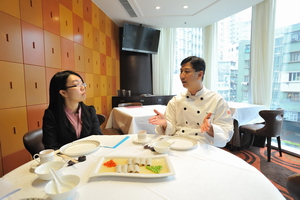
Steamed Bamboo Pith Rolls with Black Fungi and Bean Curd
| Preparation Steps | Getting to know more | |
|---|---|---|
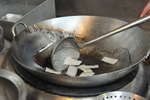 Soaking |
Soak the bamboo pith and dried black moss in water separately for 2 to 3 hours. | Soaking softens the bamboo pith and dried black moss. This step not only prepares them for further handling, but also removes contaminants such as sand and mud effectively. |
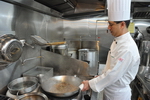 Blanching |
Blanch the bamboo pith, shredded fillings (dried bean curd, carrots, black fungi and vegetarian chicken) and garnishes (Chinese wolfberries and young soya beans) in hot water separately for a short while. Drain them dry. | Ingredients blanched for a short while can absorb flavours better. Blanching can also remove possible pesticide residues. |
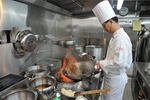 Stir-frying |
Stir-fry the fillings in wok briskly and season with chicken soup. Add corn flour water to thicken the sauce. | Brisk stir-frying retains the nutrients of food. It also cooks food thoroughly without sacrificing the colour, aroma and flavour of the food. |
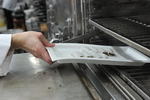 Steaming |
When the fillings have cooled down a little, pipe it into the bamboo pith rolls with a piping bag. Put the dish in the steam cabinet to steam for 5 minutes. | The fillings can either be piped into the bamboo pith rolls right away or be left to cool down for later use at a temperature of 4 ℃ or below. However, to ensure food safety, it should not be stored at room temperature for more than 4 hours. |
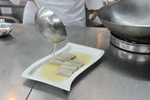 Saucing |
Prepare the sauce with chicken soup, salt, sugar, pepper powder and corn flour water. Pour the thickened sauce onto the bamboo pith rolls. Garnish the dish with Chinese wolfberries and young soya beans. | Ensure that the chicken soup has been kept boiling for at least 1 minute before pouring it onto the steamed bamboo pith rolls. |
Tips from KO:
Chef KO from Jasmine Garden told us about their measures for safeguarding food safety.
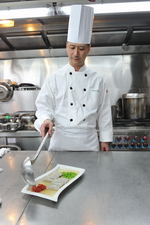
Chef KO demonstrates how to prepare "Steamed Bamboo Pith Rolls with Black Fungi and Bean Curd"
- Buy ingredients from reliable suppliers to ensure guaranteed qualities and hygiene standards of the food purchased.
- Upon receipt of the ingredients, colleagues from the quality control section will check carefully to ensure that the products are up to standard. When the ingredients are delivered to the branches of the restaurant, colleagues from the kitchen section will conduct quality checks again. If unsatisfactory items are found, they will report to the quality control section immediately. To safeguard food safety and maintain reputation of the restaurant, the colleagues concerned will closely monitor the performance of the suppliers.
- Jasmine Garden attaches great importance to environmental hygiene of the kitchen. From cooking utensils to worktops, the floor and the wall, everything has to be clean and hygienic.
- The staff will put on clean gloves before touching cooked ingredients. When Chef KO demonstrated how to prepare the dish, he practised what he said by putting on disposable gloves before stuffing the bamboo pith rolls to prevent direct contact between his hands and the food.
- Chef KO also inspects various branches of the restaurant regularly to ensure that quality of the food is of the same standard and performance of the staff meets the requirements with a view to producing fine cuisine which is high in standard and safe to consume.
Jasmine Garden has become a signatory of the Food Safety Charter for three consecutive years since 2009. It has fulfilled its mission as a signatory and joined hands with the Government to promote food safety to the public.
Food Safety Plan Corner
Steamed Bamboo Pith Rolls with Black Fungi and Bean Curd
Critical Control Point – Cook Food Thoroughly
 |
 |
||
 |
 |
 |
 |
 |
 |
Ingredients:
Bamboo pith, dried bean curd, carrots, dried black moss, black fungi, vegetarian chicken, Chinese wolfberries and young soya beans
Seasoning:
Salt, sugar, pepper powder, corn flour and chicken soup
Steps:
- Cut bamboo pith into sections. Soak and bring them to a quick boil. Season with chicken soup.
- Rinse and shred dried bean curd, carrots, dried black moss, black fungi and vegetarian chicken . Bring them to a quick boil. Add chicken soup, corn flour and oil as seasoning. Stir-fry until cooked and leave to cool.
- Stuff the bamboo pith rolls with the shredded dried bean curd, carrots, dried black moss, black fungi and vegetarian chicken. Steam for 5 minutes and dish up. Pour the sauce made from chicken soup, salt, sugar, pepper powder and corn flour onto the bamboo pith rolls.
- Rinse the Chinese wolfberries and young soya beans. Bring them to a quick boil and season with chicken soup. Place them beside the bamboo pith rolls for garnishing.
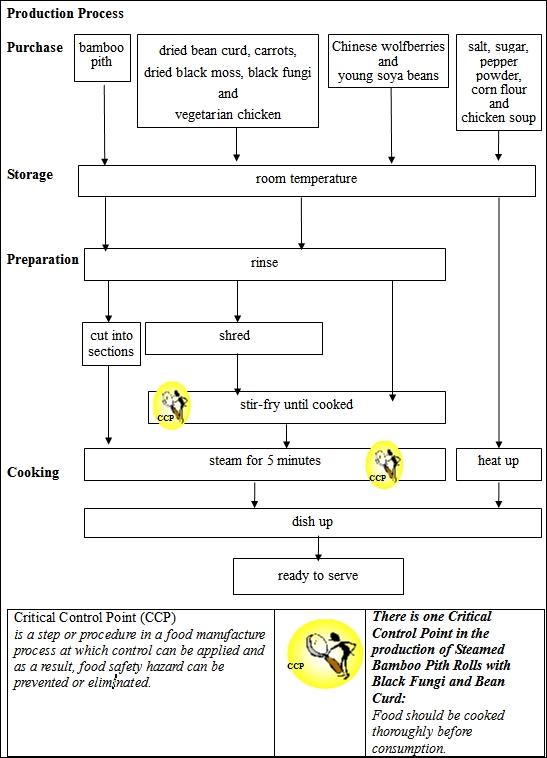
Food Safety Q&A
| Question: |
Will all prepackaged food bear nutrition labels?
|
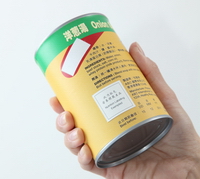 |
| Answer: |
No. According to the Food and Drugs (Composition and Labelling) Regulations, a small number of items of food are not required to bear nutrition labels, e.g.
Part 2 of Schedule 6 of the Food and Drugs (Composition and Labelling) Regulations (Cap. 132W) provides that the Director of Food and Environmental Hygiene ("the Director") may grant an exemption in respect of any prepackaged food from the requirements of Part 1 of Schedule 5 of the Regulations if the Director is satisfied that the annual sales volume of food of the same version in Hong Kong would not exceed 30 000 units. This is operated under the "Small Volume Exemption Scheme" (SVE Scheme). Members of the trade have to apply for prior approval for SVE from the Centre for Food Safety (CFS). For detailed information, please read the Guide to Application for Small Volume Exemption. Under the current legislation, formula and food intended to be consumed by children under the age of 36 months and food for special dietary uses are not mandatorily required to bear a nutrition label. However, members of the trade are encouraged to provide detailed nutrition information on the food labels of these products for reference of consumers. Members of the trade can refer to the following webpage of the CFS for the definition and scope of the Nutrition Labelling Scheme as well as the definition and examples of special dietary food: http://www.cfs.gov.hk/english/programme/programme_nifl/programme_nifl_faq.html |
|
Briefing of Activities
Roving Exhibitions on Food Safety Ordinance
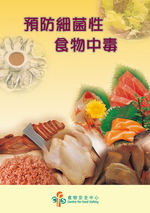
The Food Safety Ordinance came into force on 1 February 2012 . To enhance public knowledge of the Ordinance, the Centre for Food Safety (CFS) organised various roving exhibitions at markets in municipal services buildings among 18 districts in the territory. Among other things, details of the provisions were highlighted and introductory leaflets and flyers were also distributed. The exhibitions aroused great interest from stall operators and the public in these districts.
Trade Consultation Forum
The thirtieth meeting of the Trade Consultation Forum was held on 13 July 2011 . Agenda items included ‘amendment to Cap. 132AF in respect of dried milk, condensed milk and reconstituted milk', ‘ risk assessment report on dietary iodine intake in Hong Kong adults ', as well as the feasibility of adjusting the rate of fee chargeable for Small Volume Exemption (SVE) applications regarding nutrition labelling. In addition, the CFS sought views from members of the trade on the review of strengthening enforcement actions. Representatives of the CFS also briefed the trade on the u pdated situation in the examination of radiation level in food imported from Japan and m easures taken by the CFS to follow up on the plasticiser contamination incident in Taiwan. Last but not least, the proposed regulatory framework for pesticide residues in food in Hong Kong and relevant technical issues were also discussed at the meeting.
The CFS held the thirty-first meeting of the Trade Consultation Forum on 9 September 2011 . At the meeting, the CFS reported the latest situation of the SVE applications and gave an account of the latest developments of the following food safety issues, including the progress of follow-up actions on plasticiser contamination and the progress update on the public consultation on the Proposed Regulatory Framework for Pesticide Residues in Food in Hong Kong. In addition, the issue of mushroom poisoning was also discussed, with a view to enhancing the awareness of the trade and making recommendations on relevant precautionary and regulatory measures. The meeting was also briefed on the thirty-fourth session of the Codex Alimentarius Commission. Lastly, a brief of the Food Safety Charter was made to encourage active participation of the trade.
The thirty-second meeting of the Trade Consultation Forum held on 9 December 2011 followed up on the progress of the SVE applications and briefed on the registration of food importers and food distributors under the Food Safety Ordinance. Representatives of the CFS and the trade also discussed the details of the proposed Trade Guidelines on Preparation of Legible Food Label and the "Food for Special Dietary Use" issue under the Nutrition Labelling Scheme, including whether certain products could be classified as food for such uses. In addition, the CFS introduced to the meeting different international approaches on handling claims of prepackaged food products. It was explained that under special circumstances, traders might be asked to provide relevant information for assessment to support those claims. Finally, the draft Trade Guidelines on Safe Production of Buns and Sandwiches were also discussed with trade representatives.
Truth against Fallacy
Is it true that the longer the shelf-life of a pre-packaged food, the more the preservatives are added?
A pre-packaged food with a longer shelf-life does not necessarily mean that it contains more preservatives. In fact, the amount of preservatives added is only one of the many factors affecting the shelf-life of food.
Food of low water content or a relatively high or low pH value can itself inhibit the growth of most spoilage micro-organisms. Such food generally has a longer shelf-life than other food, even without adding preservatives. While heat treatment is a method which can effectively reduce the amount of spoilage micro-organisms in food, vacuum packaging is another way to allow food to last longer on the shelf. Moreover, freezing or chilling can also abate the breeding of spoilage micro-organisms, thus extending the shelf-life of food.
To sum up, provided we understand the properties of the food, use appropriate processing and packaging methods and store food in suitable temperatures, the right amount of preservatives will suffice to extend the shelf-life of food. Adding excessive preservatives may not significantly extend the shelf-life of food, but risks contravening the Preservatives in Food Regulation.
Brain Gym
| A. |
products at inexpensive prices |
 |
|
|
B.
|
Food and Drugs (Composition and Labelling) Regulations | ||
| C. |
75 ℃ |
||
|
D.
|
Food Safety Ordinance | ||
| E. |
over 60 ℃ |
||
|
F.
|
reliable | ||
| G. |
room temperature |
||
|
H.
|
Preservatives in Food Regulation | ||
| I. |
4 ℃ or below |
- We should patronise stores when buying food.
- Hot-served food should be held at to ensure safety of food.
- Storing food at can help extend the shelf-life.
- The use of preservatives in food is regulated by the .
- Food should be reheated so that the core temperature reaches at least before consumption.
| Answers: |
1 – F. reliable |
Enquiry and Subscription
Printed copies of the Food Safety Express can be collected at the Communication Resource Unit located at 8/F, Fa Yuen Street Municipal Services Building, 123A Fa Yuen Street , Mong Kok, Kowloon . For enquiry, please call 2381 6096. The public may also visit the website of the Centre for Food Safety ( http://www.cfs.gov.hk) for the online version.
